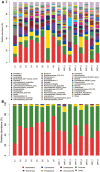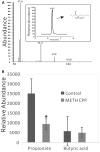Gut Microbiota Analysis in Rats with Methamphetamine-Induced Conditioned Place Preference
- PMID: 28890714
- PMCID: PMC5575146
- DOI: 10.3389/fmicb.2017.01620
Gut Microbiota Analysis in Rats with Methamphetamine-Induced Conditioned Place Preference
Abstract
Methamphetamine abuse is a major public health crisis. Because accumulating evidence supports the hypothesis that the gut microbiota plays an important role in central nervous system (CNS) function, and research on the roles of the microbiome in CNS disorders holds conceivable promise for developing novel therapeutic avenues for treating CNS disorders, we sought to determine whether administration of methamphetamine leads to alterations in the intestinal microbiota. In this study, the gut microbiota profiles of rats with methamphetamine-induced conditioned place preference (CPP) were analyzed through 16S rRNA gene sequencing. The fecal microbial diversity was slightly higher in the METH CPP group. The propionate-producing genus Phascolarctobacterium was attenuated in the METH CPP group, and the family Ruminococcaceae was elevated in the METH CPP group. Short chain fatty acid analysis revealed that the concentrations of propionate were decreased in the fecal matter of METH-administered rats. These findings provide direct evidence that administration of METH causes gut dysbiosis, enable a better understanding of the function of gut microbiota in the process of drug abuse, and provide a new paradigm for addiction treatment.
Keywords: 16S rRNA gene sequencing; gut microbiota; methamphetamine; propionates; short chain fatty acids.
Figures






Similar articles
-
Differential perturbations of gut microbial profiles and co-occurrence networks among phases of methamphetamine-induced conditioned place preference.J Neurosci Res. 2021 Nov;99(11):2860-2873. doi: 10.1002/jnr.24963. Epub 2021 Sep 12. J Neurosci Res. 2021. PMID: 34510511
-
Lycium barbarum polysaccharide mitigated methamphetamine addiction and altered methamphetamine-induced gut microbiota dysbiosis.Electrophoresis. 2024 May;45(9-10):958-969. doi: 10.1002/elps.202300190. Epub 2024 Mar 25. Electrophoresis. 2024. PMID: 38528319
-
Gut dysbiosis associated with the rats' responses in methamphetamine-induced conditioned place preference.Addict Biol. 2021 Jul;26(4):e12975. doi: 10.1111/adb.12975. Epub 2020 Oct 22. Addict Biol. 2021. PMID: 33094505
-
Related Effects of Methamphetamine on the Intestinal Barrier via Cytokines, and Potential Mechanisms by Which Methamphetamine May Occur on the Brain-Gut Axis.Front Med (Lausanne). 2022 May 10;9:783121. doi: 10.3389/fmed.2022.783121. eCollection 2022. Front Med (Lausanne). 2022. PMID: 35620725 Free PMC article. Review.
-
Dysbiosis of gut microbiota and microbial metabolites in Parkinson's Disease.Ageing Res Rev. 2018 Aug;45:53-61. doi: 10.1016/j.arr.2018.04.004. Epub 2018 Apr 26. Ageing Res Rev. 2018. PMID: 29705121 Review.
Cited by
-
Contributions of neuroimmune and gut-brain signaling to vulnerability of developing substance use disorders.Neuropharmacology. 2021 Jul 1;192:108598. doi: 10.1016/j.neuropharm.2021.108598. Epub 2021 May 6. Neuropharmacology. 2021. PMID: 33965398 Free PMC article. Review.
-
Understanding the Basis of METH Mouth Using a Rodent Model of Methamphetamine Injection, Sugar Consumption, and Streptococcus mutans Infection.mBio. 2021 Mar 9;12(2):e03534-20. doi: 10.1128/mBio.03534-20. mBio. 2021. PMID: 33688011 Free PMC article.
-
Potential roles of the gut microbiota in the manifestations of drug use disorders.Front Psychiatry. 2022 Dec 13;13:1046804. doi: 10.3389/fpsyt.2022.1046804. eCollection 2022. Front Psychiatry. 2022. PMID: 36590616 Free PMC article. Review.
-
Gegen-Qinlian decoction alleviates anxiety-like behaviors in methamphetamine-withdrawn mice by regulating Akkermansia and metabolism in the colon.Chin Med. 2023 Jul 16;18(1):85. doi: 10.1186/s13020-023-00794-w. Chin Med. 2023. PMID: 37455317 Free PMC article.
-
The role of the gut microbiome in opioid use.Behav Pharmacol. 2020 Apr;31(2&3):113-121. doi: 10.1097/FBP.0000000000000538. Behav Pharmacol. 2020. PMID: 31895059 Free PMC article. Review.
References
LinkOut - more resources
Full Text Sources
Other Literature Sources

